Paleontology
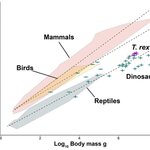
A year ago, corporate media promoted the provocative claim that dinosaurs like Tyrannorsaurus rex had so many neurons they had to be substantially more intelligent than assumed, since these high neuron counts could directly inform on intelligence, metabolism and life history.
They even added that T. rex was monkey-like in some of its habits and may even have used cultural transmission of knowledge as tools. Corporate media sells ads so they love such 'scientists are baffled by' narratives and a scenario where dinosaurs could be ruling on other planets. Other scientists were instead baffled…
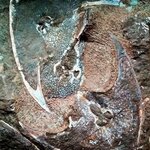
A Devonian bony fish mortality plate showing a lower shield of Zenaspis podolica (Lankester, 1869) from Lower Devonian deposits of Podolia, Ukraine.
While war rages on in the Ukraine, our hearts go out to those who live and work here contributing much to our understanding of Podolia, a historic region in Eastern Europe, located in the west-central and south-western parts of Ukraine, in northeastern Moldova.
Looking at a map of the Ukraine, I imagine a torch touching the edges that mental map alighting it with flame — the edges slowly burning and curling in as the world watches and good…
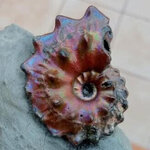
Sheer beauty — a beautiful Euhoplites ammonite from Folkstone, UK. These lovelies have a pleasing chunkiness and oil-in-water coloring.
Euhoplites is an extinct ammonoid cephalopod from the Lower Cretaceous, characterized by strongly ribbed, more or less evolute, compressed to inflated shells with flat or concave ribs, typically with a deep narrow groove running down the middle.
In some, ribs seem to zigzag between umbilical tubercles and parallel ventrolateral clavi. In others, the ribs are flexuous and curve forward from the umbilical shoulder and lap onto either side of the venter.
Its…
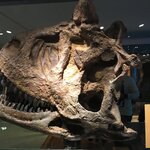
Carnotaurus sastrei, a genus of large theropod dinosaurs that roamed the southern tip of Argentina, South America during the Late Cretaceous, 72 to 69.9 million years ago. His name means "flesh-eating bull,' and he lives up to it.
This fellow — or at least his robust skull with the short, knobby eyebrow horns and fierce-looking teeth — is on display at the Natural History Museum in Madrid, Spain. For now, he is the only known genus of this species of bipedal predator.
The first specimen of Carnotaurus sastrei was found in Chubut on vast plains between the Andes Mountains and the Atlantic…

The Hallstatt Limestone is the world's richest Triassic ammonite unit, yielding specimens of more than 500 ammonite species.
Along with diversified cephalopod fauna — orthoceratids, nautiloids, ammonoids — we also see gastropods, bivalves, especially the late Triassic pteriid bivalve Halobia (the halobiids), brachiopods, crinoids and a few corals. We also see a lovely selection of microfauna represented.
For microfauna, we see conodonts, foraminifera, sponge spicules, radiolaria, floating crinoids and holothurian sclerites — polyp-like, soft-bodied invertebrate echinozoans…

Driftwood Canyon Provincial Park covers 23 hectares of the Bulkley River Valley, on the east side of Driftwood Creek, a tributary of the Bulkley River, 10 km northeast of the town of Smithers in northern British Columbia. The parklands are part of the asserted traditional territory of the Wet'suwet'en First Nation which includes lands around the Bulkley River, Burns Lake, Broman Lake, and François Lake in the northwestern Central Interior of British Columbia.
The Wetʼsuwetʼen are part of the Dakelh or Carrier First Nation, and in combination with the Babine First Nation are…
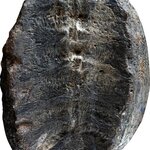
A new study re-examined these “plant” fossils from the mid-20th century and found that they weren’t plants at all: they were the fossilized remains of baby turtles.
The plants in question had been described by Padre Gustavo Huertas in 2003 as Sphenophyllum colombianum and based on collected rocks and fossils near a town called Villa de Levya.The fossils come from Early Cretaceous rocks, between 132 and 113 million years ago, during the dinosaurs’ era. Fossils of Sphenophyllum colombianum were outliers at that time and place— the other known members of the genus Sphenophyllum died out more…
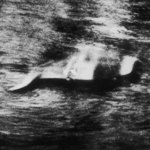
Hugh Gray was taking his usual post-church walk around Loch Ness in Scotland on a November Sunday in 1933. His amble was disrupted when he saw something bobbing above the water two or three feet from him.
He quickly snapped several pictures of what he described to the Scottish Daily Record as “an object of considerable dimensions”.
Hugh Gray took the first picture claimed to be of the Loch Ness monster in 1933. Chronicle/Alamy
A few months earlier, in April 1933, local hoteliers Aldie Mackay and her husband had described a whale-like beast to the Inverness Courier. Then, in the…
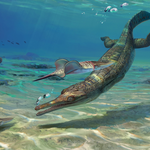
Thalattosuchians are ancient relatives of the ancestors of modern-day crocodiles, a biological aunt if you will, and part of the head, backbone, and limbs of Turnersuchus hingleyae have been found on what paleontologists call the Jurassic Coast, in Dorset of the United Kingdom.
The name derives from Paul Turner and Lizzie Hingley, who discovered the fossil in 2017. The ending “suchus,” is the Latinized form of “soukhos,” Greek for crocodile.
Turnersuchus is the oldest complete enough thalattosuchian of the Early Jurassic, Pliensbachian period, around 185 million years ago to-date. The…
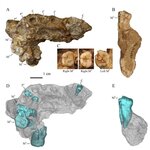
Scientists just published a study of what may prove to be China's most ancient human fossil. The researchers employed microCT, geometric morphometry, and classical morphology techniques to investigate the remains of the maxillary and five teeth from the skull unearthed at the Chinese site of Gongwangling, on the vast plains on the northern slopes of the Quinling Mountains (province of Shaanxi, in central China) and was discovered by the scientist Woo Ju-Kang in 1963.
The age of the site was reevaluated in 2015 through regional paleomagnetism studies. Those data suggest that the Gongwangling…